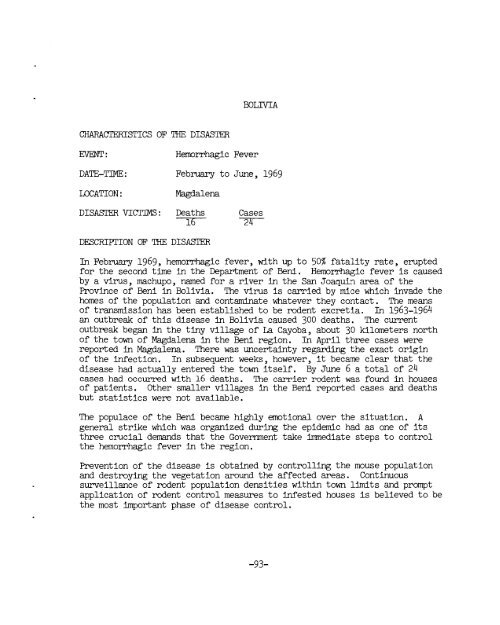3. - usaid
3. - usaid
3. - usaid
Create successful ePaper yourself
Turn your PDF publications into a flip-book with our unique Google optimized e-Paper software.
CHARAmSTICS OF THE DISASTER<br />
EVENT:<br />
Hemorrhagic Fever<br />
DATETIME: February to June, 1969<br />
LOCATION :<br />
Magdalena<br />
DISASLTE VICTIMS : Deaths<br />
16 Cases<br />
24<br />
DESCRIPTION OF THE DISASTER<br />
In February 1969, hemorrhagic fever, with up to 50% fatality rate, erupted<br />
for the second time in the Department of Beni. Hemorrhagic fever is caused<br />
by a virus, machupo, named for a river in the San Joaqui_l? area of the<br />
Province of Beni in Bolivia. The virus is carried by mice which invade the<br />
homes of the population and contaminate whatever they contact. The means<br />
of transmission has been established to be rodent excretia. In 1963-1964<br />
an outbreak of this disease in Bolivia caused 300 deaths. The current<br />
outbreak began in the tiny village of La Cayoba, about 30 kilometers north<br />
of the town of Magdalena in the Beni region. In April three cases were<br />
reported in Magdalena. There was uncertainty regarding the exact origin<br />
of the infection. In subsequent weeks, however, it became clear that the<br />
disease had actually entered the town itself. By 3une 6 a total of 24<br />
cases had occurred with 16 deaths. The carrier rodent was found in houses<br />
of patients. Other smaller villages in the Beni reported cases and deaths<br />
but statistics were not available.<br />
The populace of the Beni became highly emotional over the situation. A<br />
general strike which was organized during the epidemic had as one of its<br />
three crucial demands that the Government take mediate steps to control<br />
the hemorrhagic fever in the region.<br />
Prevention of the disease is obtained by controlling the mouse population<br />
and destroying the vegetation around the affected areas. Continuous<br />
surveillance of rodent population densities within town limits and prompt<br />
application of rodent control measures to lnfested houses is believed to be<br />
the most important phase of disease control.
















